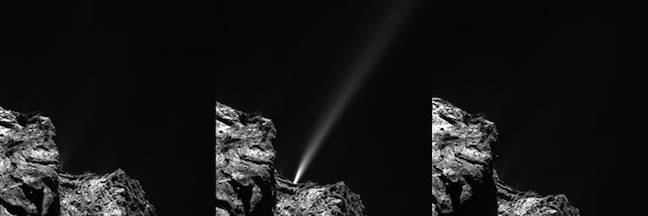This article is more than 1 year old
Chill, Philae: Shadow may protect comet lander from Sun roasting
Rosetta approaches perihelion, boffins blend excitement and nervousness
Video If the Philae lander hitch-hiking on Comet 67P/Churyumov–Gerasimenko isn't dead, its dark hiding-place might just protect it from being destroyed by the heat as comet, lander and the Rosetta spacecraft swing around the sun.
As the comet nears today's perihelion (closest approach) today (European time), the European Space Agency says Rosetta has already reported a dramatic upswing in activity on the comet.
As the agency says, one outburst was “so powerful that it even pushed away the incoming solar wind.”
And boffins are even wondering if there's a chance they'll hear from the Philae lander again. Philae didn't land as it was meant to: instead of spiking itself to the comet, the lander bounced and ended up in a spot where it wasn't able to charge its batteries from solar panels.
However, the German Aerospace Center's Manuela Braun has told Agence France-Presse that if Philae landed where it was intended, it would have been cooked back in March or April.

A brilliant jet of stuff fired off by the comet. Image: ESA
Philae's inadvertently protected location raises the tantalising prospect of again waking the lander, if mission scientists can work out a way to contact it (Philae last communicated during July, so scientists have had to cross their fingers and hope it's received a handful of commands they sent).
In the meantime, however, the mission is concentrating on the Rosetta spacecraft. They moved it to 200-300 km away from the comet to try and avoid damage from outgassings.
The ESA told AFP what's being ejected from the comet is “the greatest opportunity to catch material and analyse it if you're looking for rare species of molecules”.
If the boffins are really lucky, the 500 metre crack in the comet's duck-like neck could split completely and expose the interior, which the ESA's Mark McCaughrean described as “the Holy Grail”.
Once that danger's passed, Rosetta will be sent closer to the comet to try and re-establish contact with Philae and see if it collected any data during perihelion.
The German agency has also posted the YouTube video below describing the “crazy year” that began when the lander first arrived at 67P.
If you want to refresh yourself on any of El Reg's coverage of Rosetta, here you go. ®
